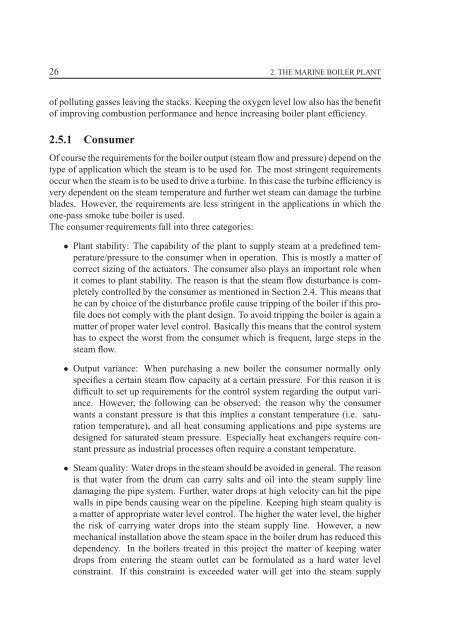Optimisation of Marine Boilers using Model-based Multivariable ...
Optimisation of Marine Boilers using Model-based Multivariable ...
Optimisation of Marine Boilers using Model-based Multivariable ...
You also want an ePaper? Increase the reach of your titles
YUMPU automatically turns print PDFs into web optimized ePapers that Google loves.
26 2. THE MARINE BOILER PLANT<br />
<strong>of</strong> polluting gasses leaving the stacks. Keeping the oxygen level low also has the benefit<br />
<strong>of</strong> improving combustion performance and hence increasing boiler plant efficiency.<br />
2.5.1 Consumer<br />
Of course the requirements for the boiler output (steam flow and pressure) depend on the<br />
type <strong>of</strong> application which the steam is to be used for. The most stringent requirements<br />
occur when the steam is to be used to drive a turbine. In this case the turbine efficiency is<br />
very dependent on the steam temperature and further wet steam can damage the turbine<br />
blades. However, the requirements are less stringent in the applications in which the<br />
one-pass smoke tube boiler is used.<br />
The consumer requirements fall into three categories:<br />
• Plant stability: The capability <strong>of</strong> the plant to supply steam at a predefined temperature/pressure<br />
to the consumer when in operation. This is mostly a matter <strong>of</strong><br />
correct sizing <strong>of</strong> the actuators. The consumer also plays an important role when<br />
it comes to plant stability. The reason is that the steam flow disturbance is completely<br />
controlled by the consumer as mentioned in Section 2.4. This means that<br />
he can by choice <strong>of</strong> the disturbance pr<strong>of</strong>ile cause tripping <strong>of</strong> the boiler if this pr<strong>of</strong>ile<br />
does not comply with the plant design. To avoid tripping the boiler is again a<br />
matter <strong>of</strong> proper water level control. Basically this means that the control system<br />
has to expect the worst from the consumer which is frequent, large steps in the<br />
steam flow.<br />
• Output variance: When purchasing a new boiler the consumer normally only<br />
specifies a certain steam flow capacity at a certain pressure. For this reason it is<br />
difficult to set up requirements for the control system regarding the output variance.<br />
However, the following can be observed: the reason why the consumer<br />
wants a constant pressure is that this implies a constant temperature (i.e. saturation<br />
temperature), and all heat consuming applications and pipe systems are<br />
designed for saturated steam pressure. Especially heat exchangers require constant<br />
pressure as industrial processes <strong>of</strong>ten require a constant temperature.<br />
• Steam quality: Water drops in the steam should be avoided in general. The reason<br />
is that water from the drum can carry salts and oil into the steam supply line<br />
damaging the pipe system. Further, water drops at high velocity can hit the pipe<br />
walls in pipe bends ca<strong>using</strong> wear on the pipeline. Keeping high steam quality is<br />
a matter <strong>of</strong> appropriate water level control. The higher the water level, the higher<br />
the risk <strong>of</strong> carrying water drops into the steam supply line. However, a new<br />
mechanical installation above the steam space in the boiler drum has reduced this<br />
dependency. In the boilers treated in this project the matter <strong>of</strong> keeping water<br />
drops from entering the steam outlet can be formulated as a hard water level<br />
constraint. If this constraint is exceeded water will get into the steam supply

















